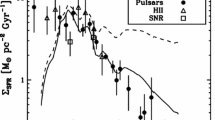Abstract
The breakdown of flux-freezing in molecular clouds and protostellar discs is usually approximated by ambipolar diffusion at low densities or by resistive diffusion at high densities. Here an intermediate regime is discussed in which the Hall term in the conductivity tensor is significant, and the vector evolution of the magnetic field, and therefore the evolution of the system under consideration is dramatically altered. Calculations of charged particle abundances in dense gas in molecular clouds and protostellar discs demonstrate that Hall diffusion is important over a surprisingly broad range of conditions.
Similar content being viewed by others
References
Balbus, S. A. and Terquem, C.: 2001, ApJ 552, 235.
Gammie, C. F.: 1996, ApJ 457, 355.
Hawley, J. F. and Balbus, S. A.: 1991, ApJ 376, 223.
Igea, J. and Glassgold, A. E.: 1999, ApJ 518, 848.
Nishi, R., Nakano, T. and Umebayashi, T.: 1991, ApJ 368, 181.
Umebayashi, T. and Nakano, T.: 1990, MNRAS 243, 103.
Wardle, M. and Salmeron, R.: 2004, Ap&SS 292, 449.
Wardle, M.: 1997, in: D. Wickramasinghe, L. Ferrario and G. Bicknell (eds.), IAU Colloq. 163, Accretion Phenomena and Related Outflows, ASP: San Francisco, p. 561.
Wardle, M.: 1999, MNRAS 307, 849 (W99).
Wardle, M. and Ng, C.: 1999, MNRAS 303, 239.
Weidenschilling, S. J. and Cuzzi, J. N.: 1993, in: E. H. Levy and J. I. Lunine (eds.), Protostars and Planets III, University Arizona Press, Tucson, p. 1031.
Author information
Authors and Affiliations
Rights and permissions
About this article
Cite this article
Wardle, M. Star Formation and the Hall Effect. Astrophysics and Space Science 292, 317–323 (2004). https://doi.org/10.1023/B:ASTR.0000045033.80068.1f
Issue Date:
DOI: https://doi.org/10.1023/B:ASTR.0000045033.80068.1f




